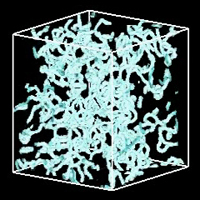Kinetic theory representation for turbulence modeling and computation
38 mins 54 secs,
143.44 MB,
iPod Video
480x360,
25.0 fps,
44100 Hz,
503.46 kbits/sec
Share this media item:
Embed this media item:
Embed this media item:
About this item

| Description: |
Chen, H (Exa Corporation)
Monday 29 September 2008, 11:30-12:00 |
|---|
| Created: | 2008-10-20 09:10 | ||||
|---|---|---|---|---|---|
| Collection: | The Nature of High Reynolds Number Turbulence | ||||
| Publisher: | Isaac Newton Institute | ||||
| Copyright: | Chen, H | ||||
| Language: | eng (English) | ||||
| Credits: |
|
||||
| Abstract: | One of the most common approximations in turbulence for the averaged effect of small scales is by the so called eddy viscosity modeling. That is, one approximates the Reynolds stress as a linear function of the local rate of strain of the averaged flow field. The proportionality constant is referred to as an eddy viscosity. This concept was first proposed over a century ago. It stems from an analogy for small eddy interactions with collisions of molecules resulting in Newtonian fluid constitutive relations. This approximation has made enormous impact particularly in computational fluid dynamics for turbulent flows. Many theoretical works were also developed since then, with various successes, in order to analytically derive such a functional relationship. However, unlike molecular interactions in a fluid, one of the apparent criticisms or difficulties in this analogy is the lack of scale separations between averaged fluid motions and fluctuating eddies. In this presentation, the speaker will give a somewhat provocative argument in favor of such analogy, provided that this concept be expanded in a generalized kinetic theory framework. In such an expanded framework, the analogy between eddy interactions and molecular collisions has a broader physical validity, while the eddy viscosity approximation is its consequence in the very long wave length limit. The kinetic theory representation itself needs not depend on scale separations. Using such an expanded analogy, one can also draw similarities between turbulent flow phenomena to that of non-Newtonian fluid flows in micro/nano scales. Nevertheless, other than phenomenological argument, as far as the speaker is aware, so far there have been little theoretical attempts to produce such a kinetic theory for turbulence on a concrete footing via first principle, if its physical soundness is acceptable.
A seminar from the Inertial-Range Dynamics and Mixing conference in association with the Newton Institute programme: The Nature of High Reynolds Number Turbulence www.newton.ac.uk/programmes/HRT/seminars/ |
|---|---|
Available Formats
| Format | Quality | Bitrate | Size | |||
|---|---|---|---|---|---|---|
| MPEG-4 Video | 480x360 | 1.83 Mbits/sec | 535.07 MB | View | Download | |
| WebM | 450x360 | 464.3 kbits/sec | 131.44 MB | View | Download | |
| Flash Video | 480x360 | 804.74 kbits/sec | 229.28 MB | View | Download | |
| iPod Video * | 480x360 | 503.46 kbits/sec | 143.44 MB | View | Download | |
| QuickTime | 384x288 | 845.2 kbits/sec | 240.81 MB | View | Download | |
| MP3 | 44100 Hz | 125.02 kbits/sec | 35.26 MB | Listen | Download | |
| Windows Media Video | 476.64 kbits/sec | 135.80 MB | View | Download | ||
| Auto | (Allows browser to choose a format it supports) | |||||

